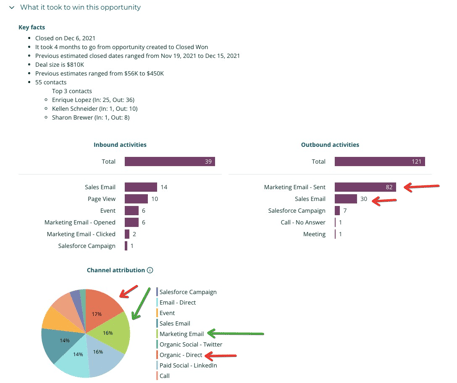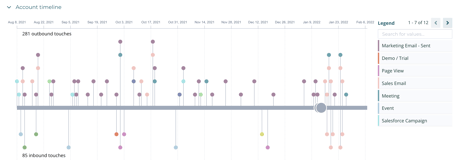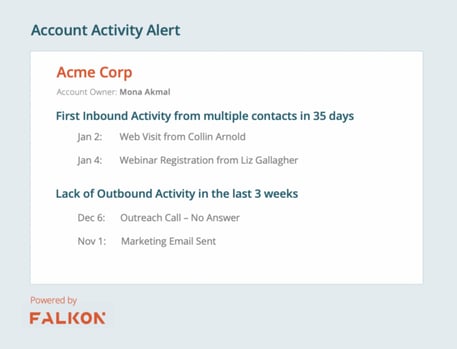The B2B SaaS go-to-market motion has recently transformed as companies transition to account-based and product-led growth motions with complex land-and-expand strategies.
Marketing isn’t only responsible for leads and pipeline generation. Sales isn’t only responsible for revenue. SDR and AE teams influence pipeline generation with marketing, just like marketing influences the AE team’s ability to close opportunities.
Yet friction points between sales and marketing prevent collaboration. These aren’t new tensions, but they need to be solved now so teams can work together toward top line metrics like revenue, new logo acquisition, and expansion.
After talking with more than 100 marketing and sales leaders, I distilled the friction into two themes: who gets credit and the blame game. Let’s look at each and how data can help teams win together.
Friction point: Who gets credit
Who really sourced this account, marketing or sales?
Not a trick question: If “outbound” is filled in as the source of an account, should credit go to sales?
Many people would say yes.
But we all know that’s not actually how pipeline generation works.
Really, the AE makes first contact, but with a compelling white paper produced by the marketing team. The white paper gets engagement, but then the contact goes dark. Marketing sends a webinar invitation and a drip campaign to re-engage, while the AE continues to reach out via email (and those emails may have been crafted by the marketing team). Eventually, multiple contacts on the account engage, a great demo meeting takes place, and the account becomes an opportunity.
Why would we reduce this process, and its myriad variations, into one field?
Reframe the question: What did it take to create this opportunity?
The answer should be: It took 12 activities to create this opportunity.
The mix of activities was:
- 20% Sales emails
- 30% Marketing emails
- 10% LinkedIn campaign
- 20% Sales meetings
- 20% White paper engagement
This is a win-together answer instead of the original win/lose answer. When your only two options are “inbound” and “outbound,” one will always lose. Teams need more complete data to accurately assign credit to both sales and marketing efforts.

We can broaden our context and apply the same logic at the aggregate level: What did it take to generate new pipeline this quarter?
The same principle applies to revenue booked: What did it take to win this deal?
The answer will always be a mix of activities that span both teams.
Why this matters
Understanding your successful activity mix rather than assigning credit to one action is powerful. Not only does it improve the relationship between sales and marketing, it helps the company create winning playbooks to close more deals, with higher predictability. At the aggregate level, it provides a roadmap for budget allocation backed by the data of which activities are driving results.
Friction point: The blame game
Sales says marketing isn’t generating enough pipeline, marketing says sales isn’t following through on leads.
When pushing to meet aggressive growth goals, even the best among us have made these kinds of accusations. And we’ve made them without good data to back up our claims because we don’t have visibility into each other’s systems and workflows.
How does a marketing team know if SDRs and AEs are following up on leads and opportunities in a consistent way?
How does a sales team know if marketers are generating the right volume and quality of leads and pipeline?
I’ve found three ways to ease this friction.
- Shared visibility in one place
- Data-driven SLAs
- Automated monitoring
Shared visibility
Shared visibility requires the aggregation of granular marketing and sales data in one place. It needs to include every activity, touchpoint, contact, account, etc. This data should be unified to present a 360 view both at the individual account level and in aggregate.

When each team can see everything that’s happening on an account, they can have a data-backed conversation. At the aggregate level, they can find where the funnel is leaky and decide how to fix it.
Accessing this data should be easy for marketers and sales team members. Unfortunately, that’s often not the case because of seat licensing restrictions. I could write a whole article about why Falkon will never charge by the seat (and maybe I will), but visibility is the heart of it.
Data-driven SLAs
SLAs often come with questions around where the expectations originated and who’s responsible for tracking them (which we’ll address in a moment).
Your unified data will hold insights that you can turn into SLAs rather than going by what feels right to one team or another. And it will have information per segment.
For example, enterprise accounts in a particular region are five times more likely to advance when three contacts on the account receive one outbound touch every week for the first four weeks.
Work backwards to set SLAs based on what already works for your teams, and create SLAs for both marketing and sales activities.
Automated reporting
Once your data is visible in one place and your SLAs are set, you need an intelligent automated system (not a nagging person) to track the SLAs in relation to leads, contacts, accounts, and opportunities. Then, the system should notify the right people on each team to take action.

Sometimes, the action will be an AE reaching out. Others, it will be marketing creating a new drip campaign. If the system monitors all activities across teams and alerts stakeholders on both teams, there’s no longer any shaming or blaming; there’s only action that helps everyone.
Why this matters
There’s no reason to keep data in the dark. Collaboration becomes incredibly easy when team leaders are working from the same information, with the same expectations. Setting goals based on what’s already working helps both teams succeed more, together.
Wrapping up
Having spent the past two years thinking seriously about how teams can improve workflows with better data consumption, I’m in a unique position to see these solutions as reality. Maybe they sound too good to be true?
My assumptions are:
- All touchpoint data related to an account needs to be combined in one place where any business leader can easily consume it.
- Account data needs to be aggregated in a place where trends can be easily understood.
- The only way to accurately assign credit for revenue is to consider every touchpoint in relation to successful deals.
- Playbooks and SLAs should come from data around what already works to drive revenue.
- Leaders should receive automated reports when accounts fall outside of data-backed parameters.
The tools are here today, so I believe that these assumptions will become commonplace in the near future, and will allow teams to succeed more, together.
Want more articles like this? Follow Falkon on LinkedIn >
